| ICE-1 |
![]()
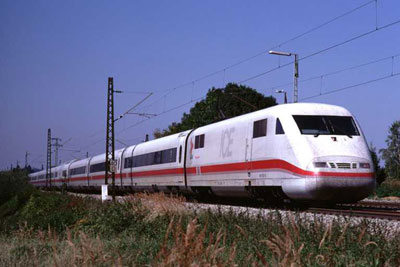 |
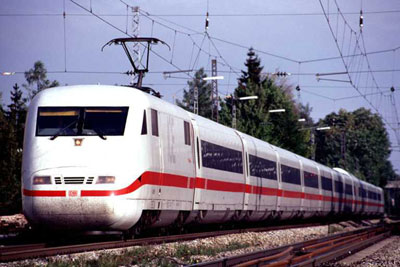 |
| ICE-1 entered in service
in June 2, 1991. ICE-1 cars were built from 1989 to 1993 by German famous enterprises such as AEG, Siemens, ABB. ICE-1 cars are based on IC-Experimental. ICE-1 is ordinary used for domestic service, but some connect to Austria and Switzerland. 60 sets of ICE1 were built. Both ends are locomotives (Class 401), and 9-12 vehicles (Class 801/802/803/804) are coupled between them. The color of ICE is white with red and pink line, and big ICE logos are painted on every side of class 401. All units of ICE-1are allocated at Bw Hamburg 1. From 1998, train sets of ICE-1 are being repainted to new livery (Verkehrsrot) . In June 1998, ICE-1 met an accident, and about 100 people were killed. Then ICE-1 was operated in shorter units - 8-car. ICE-1 is used in the lines, Hamburg - München, Berlin - München, Hamburg - Basel, Hamburg - Stuttgart, and Berlin - Düsseldorf - Frankfurt - München. |
![]()
| 1. Locomotives |
| Class 401 (001-020 / 051-090 / 501-520 / 551-590 : 120 cars) |
 |
| 120 locomotives of class 401 were built
for 60 ICE-1 trains.
Usually 401000 is coupled in one
end and 401500 in the other. (In around 1997 two
locomotives of class 402 (The locomotives for ICE-2) are coupled in both
sides of some ICE-1 units. Class 401 adapt to German electric system (AC15kv, 16-2/3Hz). ICE-1 can run at 310km/h with 14 carriages. It takes 3m20s to reach 200km/h from the start. When in service, ICE-1 is operated with the top speed of 250km/h (When delayed, it run at 280km/h.) 38 of 120 locomotives of class 401 have second pantograph to connect to Switzerland. |
![]()
| 2. Carriages |
| Four types of carriages were built for ICE1 ; class
801 for 1st class coach, 802 for 2nd class coach, 803 for 2nd class coach
and service car, and 804 for dining car. The length of them is 26.4m, width 3.02m, and height 3.84m (class 804 : 4.06m.). Their bodies are made of alminum and each carriage has double-disc brake.The width of the passages on the board is 1,100m. |
![]()
| Class 801 (001-098 / 401-440 / 801-860 / 901 : 199 cars) |
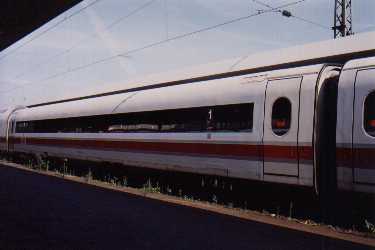 |
| Class 801 is used as a 1st class coach,
but occasionally as a 2nd class coach. The carriage has open seating area and 3 compartments. In the middle of the coach, 16 seats which we can turn to the opposite direction are aranged in 2+1 rows. In one end, 17 seats which we cannot turn are aranged in 2+1 and passengers sitting on these seats face each other across a fixed table. In the other end, there are 3 compartments in which 5 people can be seated. So class 801 has a seating capacity of 48. In this carriage, there are lockers, two wardroves, a toilet, a telephone, and so on. And in the open seating area of class 801 800, 16 seats which can be turned have each video screens. Class 801 900 does not have any compartments. That is because this carriage is based on class 805 (The carriage for ICE-2). This carriage has a seating capacity of 54. |
![]()
| Class 802 (001-098 / 301-458 / 601-660 / 801-860 / 901-924 : 400 cars) |
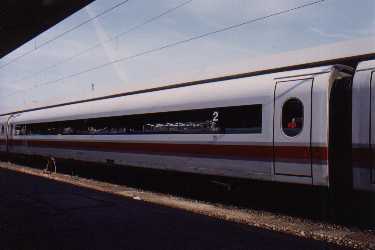 |
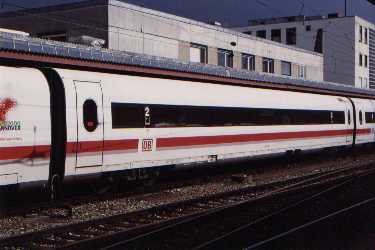 |
| Class
802 is used as a 2nd class coach. The carriage has open seating area and
5compartments. In the middle of the coach, 20 seats which we can turn to
the opposite direction are aranged in 2+2 rows. In one end, 22 seats which
we cannot turn are arranged in 2+2 and passengers sitting on these seats
face each other across a fixed table. In the other end, there are 4 compartments
in which 6 people can be seated. So class 802 has a seating capacity of
66. Like class 801, class 802 has lockers, two wardroves, a toilet, a telephone. And in the open seating area of class 802 800, 20 seats which can be turned have each video screens. Class 802 900 does not have any compartments. That is because this carriage is based on class 806 (The carriage for ICE-2). This carriage has a seating capacity of 73. |
![]()
| Class 803 (001-060 : 60 cars) |
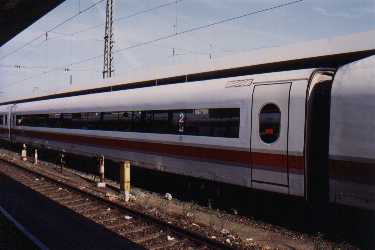 |
| Class 803 is coupled between class 802 and 804, and is called `service car`. Most part of this cariiage is 2nd class open seating area. In this area, 17 seats which we can turn to the opposite direction are aranged in 2+2 rows, and 22 seats which we cannot turn are aranged in 2+2 and passengers sitting on these seats face each other across a fixed table. 39 people can be seated on this carriage. And this carriage has a conference room, a train conducter`s compartment, a telephone room, a space and a toilet for disabled people, the control center of FIS(the information system on board). |
![]()
| Class 804 (001-060 : 60 cars) |
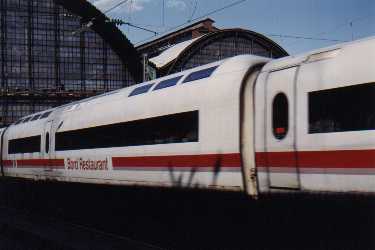 |
| Class 804 is a dining-car coupled between class 801
and 803. The ceiling of class 804 is higher than any oter carriage, and
only this carriage has some windows on its ceiling. Class 804 is called "Bord Restraunt". The kitchen is in the middle of this carriage, and the restaurant is in one end. In restaurant 24 chairs are arranged in 2+1 rows and people sitting on these chairs face each other across a table. The snack bar is in the other end. In this bar, there are 4 tables and benches on which 16 people can sit. |
![]()
| The Train Composition of ICE-1 |
| There are some types of train composition of ICE-1. The number of class 801 wagons or class 802 wagons is different among the units. |
| 401.0 - 802.8 - 802.6- (802.0 or 802.3 or 802.9) X 5 - 803 - 804 - (801.0 or 801.4 X2) - 801.8 - 401.5 |
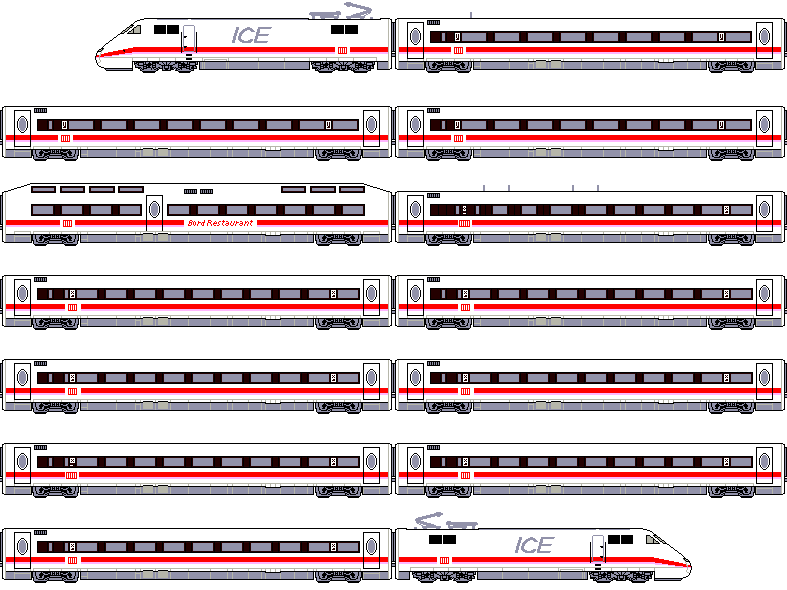 |
![]()
| The World Tour of ICE1 |
| ICE-1 was planed to be sold not only for DB but also for foreign railways.
And South Korea and U.S had a interest in ICE, and some ICE cars were carried
to these countries. (1)South Korea From February 3 1991 to March 9, class 401 555 and class 801 017 were on display in Seoul at an exhibition, TECHNOGERMA SEOUL `91. But South Korea decided to adopt TGV instead of ICE. (2)United States of America In 1993, 8 ICE cars (401 084/401 584/801 856/802 855/802 657/802 438/803 056/804 051) were carried to U.S and operated by Amtrack for some trains such as a train between New York and Washington D.C. But Amtrack didn`t adopt ICE, too. |
![]()
| The Accident in Eschede |
| In June 4 1999, ICE-1 (401 051 -) met an accident near Eschede. By
this, about 100 people were killed, and most of the vehicles of this set
were broken down. This accident was thout to be due to the damage of two-block
tyre of one vehicles. After the accident, ICE-1 was retired from service and checked. The two-block tyres of ICE-1 coaches are exchanged by one-block tyres. Most vehicles were scrapped, but the locomotives (401 051/551) were being repaired. Now ICE-1 have returned to its normal operation. |
![]()
| Pictures of ICE-1 |